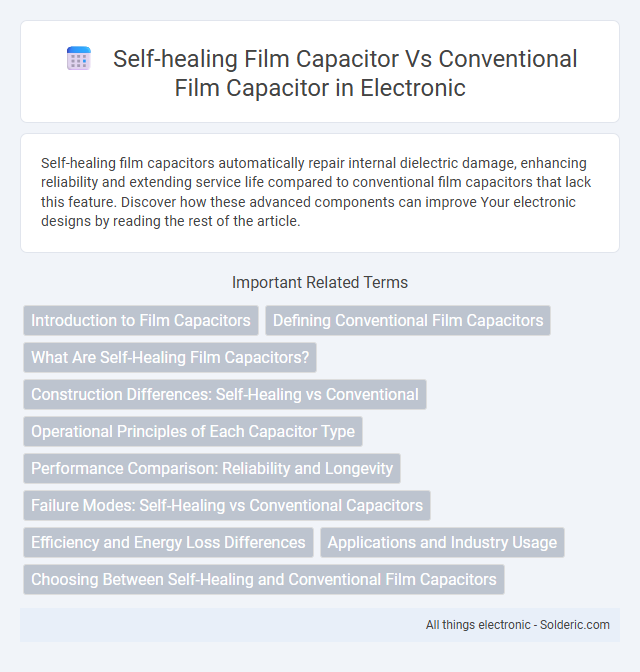Self-healing film capacitors automatically repair internal dielectric damage, enhancing reliability and extending service life compared to conventional film capacitors that lack this feature. Discover how these advanced components can improve Your electronic designs by reading the rest of the article.
Comparison Table
| Feature | Self-Healing Film Capacitor | Conventional Film Capacitor |
|---|---|---|
| Dielectric Material | Polypropylene or polyester with self-healing properties | Standard polypropylene or polyester films |
| Self-Healing Capability | Automatically isolates faults by vaporizing damaged film area | No self-healing; failure leads to breakdown or short circuit |
| Reliability | Higher due to self-healing and fault tolerance | Lower; prone to permanent failure under stress |
| Lifetime | Extended operational life under electrical stress | Shorter life, susceptible to dielectric breakdown |
| Applications | Power electronics, pulse power, high voltage circuits | General purpose, lower stress circuits |
| Cost | Higher due to advanced manufacturing | Lower; simpler construction |
| Failure Mode | Localized self-healing prevents catastrophic failure | Catastrophic failure with potential short circuit |
Introduction to Film Capacitors
Self-healing film capacitors use metallized film layers that can automatically repair minor dielectric punctures, enhancing reliability and lifespan compared to conventional film capacitors with foil electrodes. These capacitors maintain performance under stress conditions by isolating fault areas, thus preventing catastrophic failure and ensuring continuous operation. Typically used in power electronics and industrial applications, self-healing film capacitors offer superior durability and efficiency over traditional film capacitor designs.
Defining Conventional Film Capacitors
Conventional film capacitors use metalized or foil electrodes separated by a solid dielectric film, typically polyester or polypropylene, providing stable capacitance and low loss for general electronic applications. They rely on physical electrode layers that may suffer permanent damage from electrical failures, resulting in reduced lifespan or failure. Your choice between self-healing and conventional film capacitors hinges on whether the capacitor's ability to isolate and repair dielectric breakdowns is critical for your design's reliability.
What Are Self-Healing Film Capacitors?
Self-healing film capacitors feature a dielectric layer that can repair itself after electrical breakdown by vaporizing the affected area, restoring functionality without significant performance loss. This capability enhances reliability and extends lifespan compared to conventional film capacitors, which lack self-repair mechanisms and may fail permanently after dielectric damage. Commonly used in power electronics and pulse applications, self-healing capacitors improve system safety and maintenance intervals by minimizing failures caused by dielectric imperfections.
Construction Differences: Self-Healing vs Conventional
Self-healing film capacitors feature a unique construction where multiple thin metallized film layers are designed to isolate and repair micro-short circuits through localized evaporation, enhancing reliability and lifespan. Conventional film capacitors typically use foil electrodes that lack this self-restoring ability, making them prone to permanent damage when dielectric faults occur. Your choice of capacitor depends on the need for durability and maintenance-free operation, with self-healing types offering superior protection in demanding applications.
Operational Principles of Each Capacitor Type
Self-healing film capacitors utilize a thin metallized film layer that vaporizes localized faults, allowing the capacitor to maintain functionality without failure, whereas conventional film capacitors rely on separate metal foils that do not offer self-repair capabilities. The self-healing process enhances reliability and longevity by isolating short circuits instantly, reducing the risk of catastrophic breakdowns. Your choice of capacitor type should consider whether uninterrupted performance and fault tolerance are critical for your application.
Performance Comparison: Reliability and Longevity
Self-healing film capacitors exhibit superior reliability and longevity compared to conventional film capacitors due to their ability to automatically isolate and repair dielectric faults, preventing permanent damage and extending operational life. Conventional film capacitors lack this self-repair mechanism, making them more susceptible to catastrophic failure when dielectric breakdown occurs. Your applications demanding high endurance and minimal maintenance benefit significantly from the enhanced performance and stable capacitance retention of self-healing film capacitors.
Failure Modes: Self-Healing vs Conventional Capacitors
Self-healing film capacitors exhibit enhanced reliability by autonomously repairing dielectric breakdowns through localized vaporization of metalized electrodes, preventing permanent short circuits and extending lifespan. Conventional film capacitors lack this self-repair mechanism, leading to irreversible failures and increased risk of catastrophic damage when dielectric faults occur. The self-healing feature significantly reduces failure rates in demanding electrical environments compared to traditional film capacitors.
Efficiency and Energy Loss Differences
Self-healing film capacitors exhibit superior efficiency due to their ability to isolate and repair dielectric faults internally, minimizing energy loss and extending operational lifespan compared to conventional film capacitors. Conventional film capacitors suffer higher energy dissipation because breakdowns lead to permanent damage, causing increased leakage currents and reduced dielectric reliability. The self-healing feature significantly reduces dielectric degradation and energy loss, optimizing performance in high-voltage and high-frequency power electronics applications.
Applications and Industry Usage
Self-healing film capacitors are widely used in high-reliability applications such as power electronics, renewable energy systems, and electric vehicles due to their ability to recover from dielectric breakdowns, ensuring longer operational life and enhanced safety. Conventional film capacitors, commonly found in general-purpose electronics and low-cost consumer devices, lack this self-repair feature, making them less suited for critical or high-stress environments. Your choice between these capacitors should consider the application's demand for durability, operational stability, and maintenance requirements within industries like automotive, aerospace, and industrial automation.
Choosing Between Self-Healing and Conventional Film Capacitors
Self-healing film capacitors offer enhanced reliability by automatically repairing dielectric breakdowns, making them ideal for high-voltage and high-stress applications, whereas conventional film capacitors lack this capability and may suffer permanent damage under similar conditions. Selecting between self-healing and conventional film capacitors depends on factors such as operational voltage, environmental stress, and long-term durability requirements. Engineers prioritize self-healing capacitors for circuits requiring longevity and fault tolerance, while conventional capacitors suit cost-sensitive or low-stress environments.
self-healing film capacitor vs conventional film capacitor Infographic

 solderic.com
solderic.com